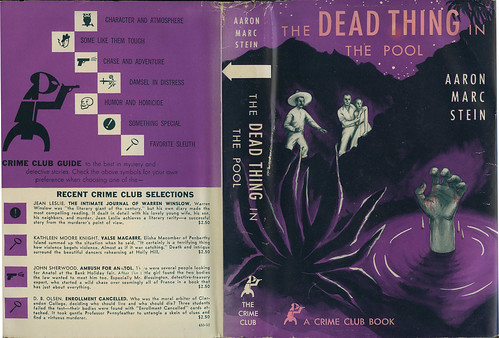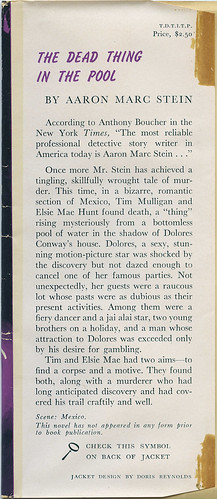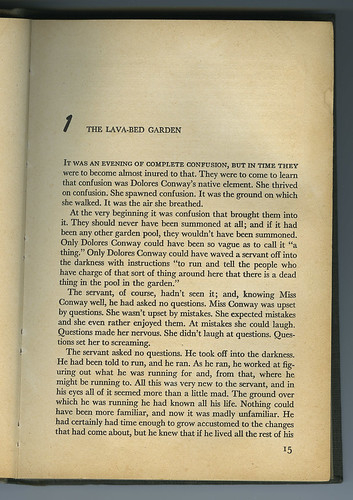"The dead thing in the pool" is actually something I've said more than once in my life. I've come in from the backyard and said, "Hey, did you see the dead thing in the pool?" which is usually followed by, "What is it?" "I don't know. Gopher/frog/possum/what-cha-ma-call-it. It's bloated and disgusting."
From everything I've read online, Aaron Marc Stein was a good mystery writer. Unfortunately, the first time I ever heard of him was when I found this book with the questionable jacket. He's one of those writers whose work is now nearly forgotten. Few writers go down in history maintaining the following they had when they were alive. People today who crave fame in all aspects of their lives might want to remember that. Here today, gone tomorrow.
A couple weeks ago I featured some old book jackets from books that had sat on the shelves at the family cabin for over 30 years. All those times I was in the cabin during snow storms, unable to get out to go skiing, a bit bored out of my mind, and I never once considered reading any of these books because the jackets were so bad. I also never threw them away because...the jackets were so bad. The jackets made me laugh. Okay, I'm older now, hopefully a bit more mature, and I'm betting some of these might have been interesting books to read. The jackets invariably are what kept me away. They were designs of their time and often times really bad. This one is from 1952.
I'll let you decide for yourself the merits of this particular jacket. I have a feeling the designer, Doris Reynolds, was at the mercy of the advertising department and some bad editors. Then again, maybe the author had too much input. That happens way too often thanks to the fine print in contracts.
First I'll deal with Doris Reynolds, what little I can find about her. She was born in 1912 and died in 1978. She lived in New York where she studied at the Art Students League. According to AskArt.com, provided by Kayne Slotnick:
Doris Reynolds did many illustrations for books published by Doubleday & Co. She was also an exhibiting artist, having work shown at the Krausharr Gallery in New York in 1949.Other exhibitions include: Wilmington Museum, Delaware 1940-45; Maracaibo 1936-39; Barbizon Plaza, NYC 1940; Lake Placid Club, NY 1940, etc. She studied at the Art Students League with Jules Gotlieb, Bridgman & Brackman. During World War II, she was one of Jackie Corcorano's Girls, ferrying airplanes throughout the United States.
Well, isn't that interesting? She ferried planes during World War II. I just did a post about women pilots of WWII on March 12. Once again, I never know where ephemera will take me.
I'm actually guessing that though the jacket design was done by Doris Reynolds this doesn't mean she did the jacket art. Looking at a few examples of her work at AskArt.com you'll see little similarity between what I'm showing here and what they have. The truth is I just don't know.

As to author Aaron Marc Stein (1906-1985), who also published under the names George Bagby and Hampton Stone:
Stein was born in 1906 in New York City. He attended Princeton University, graduating with a degree in archaeology and also summa cum laude . His early avante-garde novels came to the attention of Theodore Dreiser and were published, but he did not gain much fame till he moved into writing mysteries. In addition to Bagby, he also published mystery novels under his own name, and under the pseudonym "Hampton Stone."He held a position as a radio critic for a New York newspaper in the 1930s, and then went to work for Time magazine. During World War II he worked as with the US Army. His army work may have involved cryptography or language translation.Over 100 novels by Stein eventually saw publication, and for his lifetime achievements the Mystery Writers of America awarded him as a Grand Master in the 1979 Edgar awards. His final book was published in 1984, entitled "The Garbage Collector". Stein died at the age of 79, of cancer, on August 29, 1985.Primary worksIn addition to the hero of most of the Bagby novels, Inspector Schmidt, Stein also created a New York City Assistant District Attorney named Jeremiah Gibson for the books published under the Stone pseudonym, and archaeologist detectives Tim Mulligan and Elsie Mae Hunt, as well as engineer Matt Herridge, for the mysteries published under his own name. 1930 was the year of the publication of Stein's first novel. His first mystery was published in 1935, "Murder at the Piano." The first novel written as Stone was entitled "The Corpse in the Corner Saloon." It was reviewed in the New York Times in 1948, though, when the series was republished in 1968-1971, "The Corpse in the Corner Saloon" was labeled as book 10 in the series. (SOURCE: WIKIPEDIA)
Writing under the name Bagby:
Bagby's focus was on police investigators, especially the fictional Inspector Schmidt, Chief of Homicide for the New York Police Department. In the Schmidt novels, mystery-writer Bagby himself appears as "the Watson to Schmidt's Holmes, following him on cases, and acting as biographer." A number of his novels have been translated into other languages, including German, French and Spanish. (SOURCE: WIKIPEDIA)
I also found this piece written by Francis M. Nevins at Mystery File where they also include a few old cover/jacket designs:
FIRST YOU READ, THEN YOU WRITEby Francis M. NevinsThere’s a general rule to which the most conspicuous exception in our genre is Agatha Christie: when an author dies, his work dies too. Certainly Aaron Marc Stein’s has. He was born in 1906, graduated summa cum laude from Princeton, wrote a couple of avant-garde novels which were published thanks to endorsements from Theodore Dreiser, then turned to mystery fiction under the pseudonym of George Bagby and, a few years later, under his own name too.He quickly learned how to parlay his day jobs and other activities into backgrounds for the early Bagby novels, using his time as radio critic for a New York paper to create his own station in Murder on the Nose (1938), dipping into his memories of apparently liquor-soaked Princeton reunions for The Corpse with the Purple Thighs (1939), employing his stint at the madhouse known as Time magazine in Red Is for Killing (1941).During World War II he abandoned fiction to serve as an Army cryptographer, but after the war he became a full-time author and wrote so prolifically and skillfully that in the early 1950s, when he was turning out four or more titles a year, New York Times mystery critic Anthony Boucher called him the most reliable professional detective novelist in the United States.Between 1935 and his death half a century later he produced an astounding 110 book-length mysteries: 51 as Bagby chronicling the cases of the NYPD’s sore-footed Inspector Schmidt; 18 as Hampton Stone about New York Assistant District Attorneys Gibson and Mac; 18 under his own name with the archaeologist-detective duo of Tim Mulligan and Elsie Mae Hunt as protagonists and, when his publishers demanded stronger beer in their Steins, 23 with adventurous civil engineer Matt Erridge in the lead.Factor in his one non-crime novel as Bagby plus one stand-alone crime novel under his own name and those two early literary experiments and you have a total of 114 books. He also wrote occasional short stories, which cry out to be collected. Most of his Bagby and Stone novels are set in and around New York, which Aaron knew and loved and characterized as vividly as any of his human beings, while most of his orthonymous books feature exotic locales in Central and South America or Europe.I had been reading him since my teens but never got to spend quality time with him until the mid-1970s when we both joined the board of the University of California’s Mystery Library, and we remained friends for the rest of his life. In 1979 he received the Grand Master award from Mystery Writers of America. Later he and I served together on the board of Bantam s Collection of Mystery Classics.His health was failing but he continued to turn out a book or two a year well into his seventies. Acclaimed by colleagues and connoisseurs, he never attained the popular success he so richly deserved. He died of cancer in 1985. That was almost a quarter century ago but I still remember him fondly.Since the early 1960s he had lived in a co-op on Park Avenue and 88th Street with his sister Miriam-Ann Hagen (who also wrote a few whodunits of her own) and her husband Joe. They had bought it for $34,000 which they’d won gambling at Las Vegas in a single night. At the time of his death the unit was worth well over a million. In effect he had an apartment inside the apartment, and after he and Miriam had died Joe invited me to stay in Aaron’s quarters whenever I was in New York – which allowed me the unique experience of reading several of Aaron’s later novels in the room where he’d written them.For most readers today his huge body of work remains an undiscovered treasure. Any who care to remedy that loss would do well to begin with his books from the years when he earned that accolade from Boucher: perhaps the Bagby titles Drop Dead (1949) and Dead Drunk (1953), or The Girl with the Hole in Her Head (1949) as by Stone, or Days of Misfortune (1949) under his own name. I still reread him regularly and with pleasure.
Many of his original manuscripts are archived at the Princeton University Library. In fact it says they have:
14 linear feet (29 archival boxes, 1 oversized flat box)
I'm wondering why they didn't include weight. I'm kidding.
To see a complete list of his work click here. And to see some 1970s cover art for books published under the name Hampton Stone click here.
And as you can see by the flap copy, this book was one that featured archaeologist detectives Tim Mulligan and Elsie Mae Hunt.
Click on image to see it larger.
Perhaps I've now exposed you to an author you've never heard of. Next time you're in a used bookstore or flea market keep your eyes open for Aaron Marc Stein. And for your reading pleasure, page one.
Click on image to see it larger.















Perhaps I should read The Garbage Collector before I read The Dead Thing in the Pool. And, when I retire from my future job - inventing names for Benjamin Moore paint colors - I hope to get a job of developing the titles for mystery books like this.
ReplyDeleteI was thinking the same thing about the titles. Do you have to have a few drinks before coming up with one? Sue Grafton really took the easy way out. "A" through "Z" and that's it.
ReplyDeleteDo tell, your latest for Benjamin Moore? Ummmm...dead pool purple?
I wonder if it was ever made into a movie? I used to watch some terrible old films with my Dad, usually on a Friday night. YOu know the kind of thing "They came from outer space" with unbelievable set, storylines and 'special' effects, we used to have a good laugh at them.
ReplyDeleteJanice: Strangely I didn't find any reference to any of his work being used as the basis for movies or tv. But I just did a search of IMDB and found him with a credit as a writer for and episode of 77 Sunset Strip called "A Bargain in Tombs" dated 1959.
ReplyDeleteI'm actually going to have to read this book. I'll hide the cover and pretend I've never seen it. I'm interested to see how he handled this male/female archaeologist team.